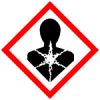The Producer must not use any pesticide listed in:
i. Annex A and B of the Stockholm Convention; or
ii. Annexes of the Montreal…
The Producer must not use any pesticide listed in:
i. Annex A and B of the Stockholm Convention; or
ii. Annexes of the Montreal…
Chemicals that are banned by the Bonsucro…

Toxic if swallowed

Causes skin irritation

Causes serious eye irritation

Toxic if inhaled

May cause respiratory irritation

Suspected of causing genetic defects (state route of exposure if it is conclusively proven that no other routes of exposure cause the hazard)

May cause damage to organs (state all organs affected, if known) through prolonged or repeated exposure (state route of exposure if it is conclusively proven that no other routes of exposure cause the hazard)

Very toxic to aquatic life
The Producer must not use any pesticide listed in:
i. Annex A and B of the Stockholm Convention; or
ii. Annexes of the Montreal…
Chemicals that are banned by the Bonsucro…

Toxic if swallowed

Causes skin irritation

Causes serious eye irritation

Toxic if inhaled

May cause respiratory irritation

Suspected of causing genetic defects (state route of exposure if it is conclusively proven that no other routes of exposure cause the hazard)

May cause damage to organs (state all organs affected, if known) through prolonged or repeated exposure (state route of exposure if it is conclusively proven that no other routes of exposure cause the hazard)

Very toxic to aquatic life